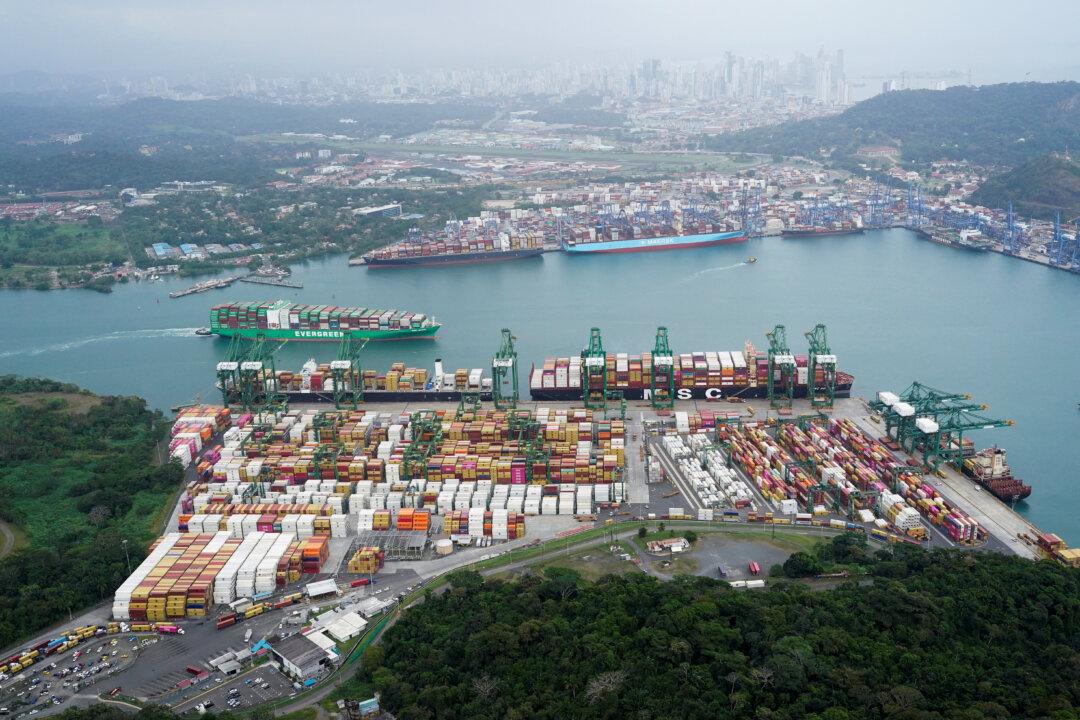Russia appears to have finally won secure access to the warm waters of the Indian Ocean, the goal it has pursued vigorously since the 17th century. The old Great Game may be over, but a new one has begun.
Russia’s new strategic logistical link and political alliances southward to the Indian Ocean have resulted from years of work, with many setbacks along the way for the Russian government of President Vladimir Putin. Many of the routes of riverine traffic, roads, and railways have been evolving in Russia over the past centuries and in Iran over the past half-century or more.
The Russian and Iranian communications lines have finally meshed. The transit passage to the Indian Ocean is already functional.
A major, unifying aspect of this transportation network was the signing by Putin and Iranian President Ebrahim Raisi via video link on May 17 of a Russian-Iranian deal to finance and build the Rasht-Astara railway link as a key part of the North-South Transport Corridor. This links with the Azerbaijani rail links and northward to the Russian rail lines.
This—provided Moscow can consolidate this new access route and ensure that it can keep the clerical government in power in Iran—decides the “Great Game” for control of key areas of the Eurasian heartland, including the Caucasus, Iran, and Central Asia, so that Russia could trade as a maritime power in the Indian Ocean.
What is significant is that the Russia-Ukraine conflict has helped stimulate progress on the new trade link, partly by helping to cement the dependence of Iran’s clerics on Russia. That may have been the final impetus for Tehran to abandon its traditional fears of Moscow. Significantly, too, is the fact that the Crimean War of 1853 to 1856 between Britain, France, and Turkey, on the one hand, and the Russian Empire, on the other, served as a marker in the Great Game.
A variation, however, in the Great Game is that the collapse of the Soviet Empire in 1991 gave independence back to the ancient khanates of Central Asia and to Azerbaijan, albeit in new geopolitical forms than before. The five Central Asian states, as well as Azerbaijan—and Afghanistan, and Pakistan to the south—create a complicating dynamic in the new strategic architecture of Eurasia. So, too, does the final semi-submission of modern Turkey, like clerical Iran, to Moscow.

The new capability starts the process of diminishing the monopoly of the Egyptian-controlled Suez Canal in dominating East-West trade links (it presently takes some 12 percent of world maritime trade).
This is something that could also be further diminished by a proposed two-stream Israeli canal—the Ben Gurion Canal—from the Mediterranean to the Gulf of Aqaba and the Red Sea. Even in this arena, the West’s grasp on the security of the Red Sea (vital to both the Suez and Ben Gurion canals) has slipped significantly in the past two years.
Moreover, the new Russian route is likely to open up the Iranian economy, which would benefit significantly from transit fees and from its ability to be a key market and supplier in the trading system, while that route and the Israeli Ben Gurion Canal offer the forecast of a reduction in Egyptian transit revenues from the Suez Canal.
The St. Petersburg to the Indian Ocean route is already a practical proposition, eliminating much of the U.S. and NATO attempts to constrain Russia strategically into northern and Arctic ports.

The failure of the United States, in particular, to support the Shah of Iran in 1978–79 was directly responsible for the seizure of control of Iran by the anti-Western Shi’a clergy in 1979, taking even the Soviets by surprise. Neither were they ready for the Shah’s collapse nor the clerics’ ensuing hostility to the West. Moscow, under the Soviets, and later the Russians, struggled to overcome the centuries of hostility toward Russia from Iran, stemming in large part from the Russian wars of conquest of the Persian lands of Central Asia and up to the Caucasus.
Today, the Caspian Sea in the heart of the Eurasian landmass is rapidly becoming the hub, or cross-section, of vital trade routes that will significantly impact the global balance of power and determine the emergence of the next major power. The streamlined new rail, road, and sea transport corridor, which crosses and follows the Caspian Sea from north to south, links Russia, through Iran, to the Persian Gulf and the Arabian Sea on the Indian Ocean.
It signifies that Russia has finally broken free from its historical geopolitical containment and has forged a stable and secure corridor to the warm waters of the Indian Ocean after centuries of the Great Game by Great Britain—via British India—and Iran, to stem Russian expansion in the 17th, 18th, and 19th centuries.
In essence, the Great Game has been decided for the moment, and Russia has its victory. Iran and India—the latter once part of the British Empire—are now firmly part of the trade link, which has Moscow’s toes settled into the warm waters of the Persian Gulf and Indian Ocean.
It has been a slow process for Moscow, but it has been progressing consistently despite such distractions as the Russia-Ukraine conflict, with the West hardly paying attention. It has also secured for Moscow a degree of independence from its enforced trading pact with Beijing.
This means that after centuries of predations by Moscow into the old Persian Empire, Iran is now successfully in the embrace of Russia, thanks to the protection Moscow provides the ruling Iranian clerics from both Western hostility and the restlessness of the Iranian population. And India, a consistent trading partner of Russia since Indian independence in 1947, is a major destination for the North-South Transport Corridor, which has—at the end of the Bandar Abbas or Chahbahar to India sea link—its terminus in Mumbai, on the Arabian Sea.

In February 2021, the Indian government recommitted to the construction of the Chahbahar to Zahedan railway project, originally agreed upon in 2016. A memorandum or agreement was signed between Indian Railways’ IRCON and Iranian Railways’ Construction and Development of Transportation Infrastructures Company (CDTIC). This accord would substantially upgrade the Chahbahar port, and the rail link north to Zahedan (also in Sistan and Baluchistan province of Iran, abutting Pakistani Baluchistan and Afghan Baluchistan) would give India the ability to trade into Afghanistan and Central Asia without having to cross Pakistani territory. Indeed, it was meant to build India’s access to Iran and Central Asia in a way that would move to the strategic rear of Pakistan.
The inexorable growth of the Russian networks into the Central Asian and Iranian rail, road, and port networks justifies the intense efforts that Moscow has made—under the Soviets and later under the Russians—to build trade into Southeast Asia and particularly with Indonesia. Jakarta was always seen as a hub of Sino-Soviet competition since the immediate post-World War II period, and it is likely again to be an area of intense Sino-Russian competition in the coming few years.
But for now, there are benefits for all players—Russia, Iran, India, China, and Central Asia—from cooperation. Pakistan, significantly, on June 11, received its first shipment of Russian oil: 45,000 metric tons aboard the Russian tanker Pure Point, which went to Karachi for Pakistan Refinery Ltd., with another 50,000 metric tons due before the end of June 2023. It was paid for in yuan (RMB), cementing the move away from dollar payments and, therefore, outside the scope of U.S. sanctions pressures.

Caspian News also noted that the International North-South Transport Corridor (INSTC) was, even by late 2021, a 4,474-mile long multi-modal network of maritime, rail, and road routes to transport freight between India, Iran, Azerbaijan, Armenia, Russia, Afghanistan, Central Asia, and Europe. The objective of the corridor was to increase trade connectivity between major cities such as Mumbai, Moscow, Baku, Astrakhan, Tehran, Bandar Abbas, Chahbahar, and Bandar Anzali (the biggest port on the Iranian Caspian coast). The aim of the corridor was not just to increase trade between member countries but also to standardize tariffs and customs duties.
The complexity of the new strategic transport infrastructure makes it difficult for the five Central Asian states to act in harmony to find a way of circumventing Russian domination of their trade with the outside world, although components of the INSTC allow, for example, for Kazakhstan and Turkmenistan to link through Iran to the Indian Ocean. For the moment, however, this route through Iran—without Russian control—would place Central Asian users in a possible confrontation with the United States because of Washington’s formal sanctions against Tehran.
This is a major constraint on the use of the INSTC by the Central Asian states, particularly Uzbekistan, the largest of the Central Asian bloc, which has worked hard to build trade and investment links with the United States and Europe.
But, if anything, the viability of the INSTC makes more likely the evolution of a trading world that totally bypasses the U.S. and dollar-linked activities, punishing the United States and its allies more than Iran or the countries that trade through it.
It is now clear that the United States is reaching the limits of using sanctions as a strategic weapon to punish adversaries.
In the meantime, Uzbekistan is working—as it has no alternative but to do—with the Taliban controllers of Afghanistan to improve the stability of overland links south from Tashkent and through northern Afghanistan to Pakistan and thence to the seaports of Karachi and Gwadar. It has not abandoned the use of links through Turkmenistan and east-west across the Caspian to Baku, Azerbaijan, and thence overland through Azerbaijani Nakhchivan to Turkey and to world markets via the Mediterranean or Black Seas.
Everywhere the routes are complicated by politics.
Central Asian traffic through the Caspian and Azerbaijan cannot escape the growing influence of Russia on the prosperity of the Caucasus, the Caspian Basin, and Iran, and, therefore, on the region’s governments. Central Asian traffic through Afghanistan and into Pakistan cannot escape the influence of China, which is the guarantor of Pakistan’s security from attack by India.
It is important not to disregard the strategic rivalry implicit from Russia to China in the INSTC. Beijing still needs its faltering Belt and Road Initiative to reach European, Middle Eastern, and African markets.
Turkey, like Iran, emerges as a key component in the plans of Moscow and the Central Asian states. And both Turkey and Iran have developed into autocracies in which the leadership is courted and protected by Moscow. Meanwhile, Central Asia—which had become a U.S. bailiwick after the collapse of the Soviet Union in 1991 as the regional states strove to build alliances to protect them from resurgent intimidation from Moscow—is now engaged in a far more complex strategic framework.
It will be more difficult for the United States and the West to regain traction in the region, although Central Asia will continue to make determined efforts to maintain a distance from Moscow and Beijing. How they do it is the next challenge for the regional leaders.





